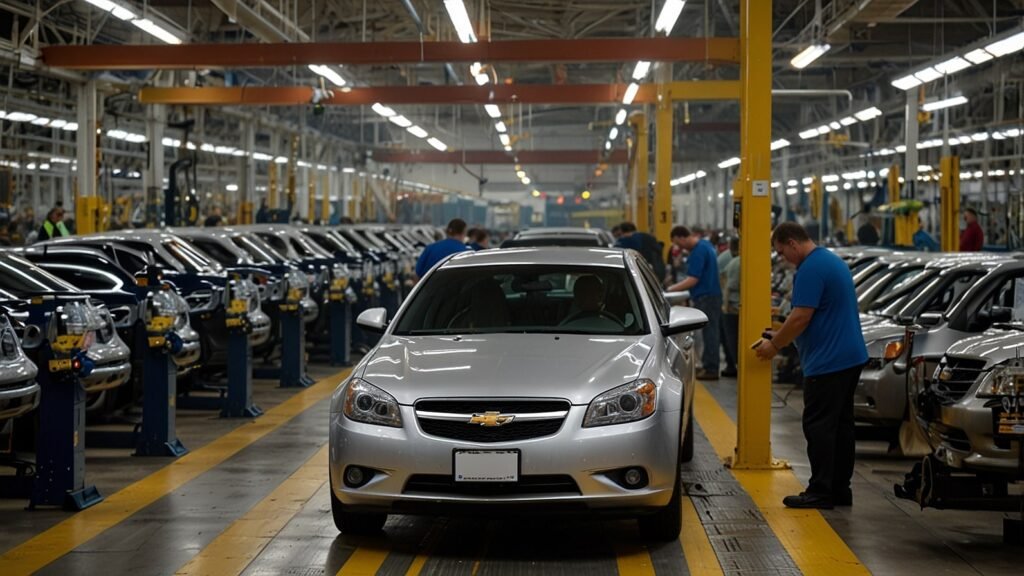
The new tariffs on imported auto parts, introduced by the recent policy, have caused tremors throughout the supply chains, affecting automakers and the consumer population under the broader trade policy aimed at enhancing domestic manufacturing. As the U.S. currently imports about $200 billion in auto parts every year, including components that are essential to pickup trucks and even those in electric SUVs, these tariffs, between 10 percent and 25 per cent on primary materials including steel, semiconductors, and batteries, will cause chaos in an industry that is already on its knees due to post-pandemic recovery and increased electrification prices. This paper examines the origins of the tariffs, their short-term and long-term effects on carmakers, their suppliers, and the general public.
The Genesis of the Tariff Push
The tariffs, which will be introduced at the beginning of 2025, are a result of a new American emphasis on domestic industry protection and an end to dependency on overseas production, predominantly Asian and European. The policy targets countries such as China, Mexico, and Canada, which collectively account for more than 60 per cent of the U.S.’s auto parts imports, and aims to encourage local manufacturers of vital parts, including lithium-ion batteries, microchips, and aluminium castings.
Its supporters claim that this protects not only American employment, 900,000+ in the automobile industry alone, but also offsets trade imbalance. The administration cites the 2022 CHIPS Act, which poured $52 billion into semiconductor production in the US, as a prelude, saying that tariffs also discourage offshoring.
However, the truth of the matter is even messier. The auto sector is characterised by a globalised supply chain, whereby the parts are subjected to cross-border movement several times before the final assembly may be done near Michigan or Alabama. An example of this is that one Ford F-150 can have a Mexican wiring harness, a Canadian transmission and Chinese electronics.
These new tariffs imposed on these cross-border flows present a threat to drive up prices in all steps along the way, and this puts the just-in-time manufacturing model that keeps the assembly lines running at risk. According to industry analysts, a 20 per cent tariff on imported steel would increase the cost of producing vehicles by 2-3 per cent, which will be passed on to the showrooms.
Short-term Effects on Suppliers and Automakers
Large car manufacturers such as General Motors, Stellantis and Toyota have expressed their concerns about the immediate implications of the tariffs. Thirty per cent of its parts are imported, and a recent announcement by GM that the levies will cost it an extra $1,500-$ 2,000 per unit will further shrink already low profit margins due to EV development expenses.
Smaller manufacturers, who do not have the size to absorb such increases, have even greater obstacles. In any case, the electric truck startup, Rivian, is dependent on imported batteries and chips. The tariff on these parts may also rise to 25 per cent, which would create pressure to raise the prices of the models, such as the R1T, which would be unaffordable to budget consumers in a highly competitive EV market.
Tier-one suppliers such as Magna and Aptiv that manufacture products such as seats, sensors, etc., are no less shaken. These companies are running on a very thin margin, and most of them do not have the infrastructure to move production to the US in a day. A Michigan supplier of dashboard electronics stated that it had seen a 15 per cent increase in costs as a result of the Taiwanese semiconductor tariffs, which made it necessary to renegotiate with its OEMs.
Existential threats to the smaller Tier-two and Tier-three suppliers, who are frequently family-owned enterprises that provide bolts or gaskets, are present because they cannot readily emigrate or incur expenses. The spillover effect is severe: according to a survey conducted by the Motor & Equipment Manufacturers Association, 70 per cent of its suppliers expect to be either laid off or to reduce their investments in case tariffs are not eliminated by 2026.
All these woes are exacerbated by the semiconductor shortage, which is a legacy of the pandemic. Although the U.S. has invested in the CHIPS Act, chip production will not reach the right scale until 2027, which means, in the meantime, automakers will be relying on Asian suppliers. Import duties on these chips, which are frequently included in the module of South Korea or Japan, add some costs with no alternative in the domestic market.
EVs have battery supply chains that have equally daunting challenges. Lithium-ion cells are largely produced in China, and an imported battery tariff of 15 per cent will not help companies like Tesla and Ford to scale up their models, such as the Mustang Mach-E. This is in an era during which EV adoption is likely to rise to 25 per cent of the U.S. sales in 2026, so affordability is a key factor.
Consumer Price and Market Forces
To the American motorists, the tariffs are a sticker shock. Based on J.D. Power’s estimates, the average price of a new vehicle, now standing at the border of $48,000, has the potential to increase by $1,000 to $3,000, depending on the type. Other examples of cars that are susceptible to entry-level cars include the Nissan Versa or Kia Forte because their profit margins are very low, and they have no room to absorb expenses.
Higher increases are experienced in hybrids and EVs, which are dependent on imported batteries and electronics. As an example, a tariff-driven add-on of $2,500 to a 40,000 Hyundai IONIQ 5 would discourage middle-class consumers from increasing green adoption.
Even dealerships are preparing to cope with turbulence. Stock levels, having finally stabilized after years of shortages, might reduce once more when the cost of production compels the automakers to reduce. Rural dealers that cater to price-sensitive consumers record initial signs of weakening demand for more expensive models. In the meantime, prices of used cars, which are already 20% higher than before 2020, might creep even higher as buyers find an alternative to new cars. Such a dynamic threatens to put the industry on stall and without mitigation of costs, sales are expected to fall by 5% by the year 2025.
Long-Term Effect and Adaptation of the Industry
In the future, the tariffs may reform the geography of the auto industry. The automakers are investigating nearshoring, where production is moved to Mexico or Canada in order to avoid part of the levies, but it will need years of investment and harmonisation of the regulatory process. The 1.2 billion dollar expansion of its Ontario assembly plant to produce the F-Series is an indication of this trend by Ford.
Still, it is overwhelming to have such expansions scaled across the entire industry. The production of the domestic parts is yet to achieve its long-term goal, having challenges in the form of labour shortages and high cost of energy. The educated labour needed to deploy battery plants as quickly as possible is unavailable in the U.S., and only 30 per cent of the planned gigafactories will be up and running by 2025.
Innovation-wise, tariffs can accelerate automation to reduce the cost of labour, but will only increase the loss of jobs in the traditional manufacturing centres such as Ohio and Indiana. On the other hand, they might drive local chain breakages. Firms such as BorgWarner are testing 3D-printed parts to avoid dependence on imports, and startups are testing recycled materials to reduce the cost. However, they are still infantile solutions, and implementing them during a time of tariff strain is a gamble.
The tariffs put a strain on trade relationships geopolitically. Some of the key partners to the USMCA, such as Canada and Mexico, have foreshadowed retaliatory action, which they can take against US agricultural exports. With the highest levies, China can redouble its internal EV market, saturating Asia with lower-priced substitutes that indirectly target American brands. These strains highlight the fine line of protectionism in an international business.
Navigating the Road Ahead
The auto parts tariffs, which are based on the dream of being self-reliant, reveal the vulnerability of an interdependent supply chain. Auto manufacturers have a dilemma: charge customers or take a loss; invest in new EVs and self-driving systems or go bankrupt; and suppliers, especially smaller ones, can merge or go out of business, decreasing competition and innovation. To the consumers, the vision of having affordable, sustainable vehicles is in the balance.
Plans of mitigation are setting in. Other automakers are lobbying to exclude some key components, such as batteries, due to national security and climate concerns. Others are speeding up collaboration with suppliers in the United States, whereas the demand exceeds the capacity.
Federal subsidies, such as the 7500 tax credit on EVs, might cushion the effect on consumers, but their future remains unclear due to budget discussions. It is also being proposed by industry groups that phased tariff implementation be implemented to allow retooling, a motion that is gaining ground in Washington.
The auto industry is at a crossroads as 2025 rolls on. The tariffs will strengthen American production at the expense of bringing to a halt a sector that is central to the economy. Carmakers, dealers, suppliers, and drivers need to adjust to a new reality where prices are increasing quickly, supply chains are changing, and resiliency is being challenged. At this point, the future of this road is uncertain, although the industry’s propensity for innovation has the potential to guide it.

